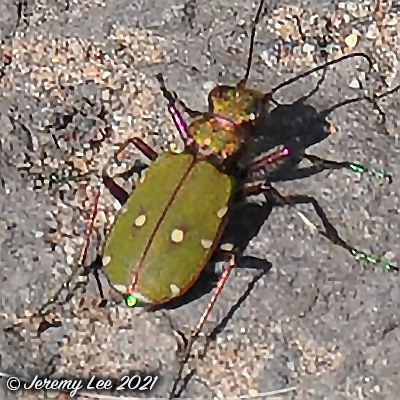
 |
|
Scientific Classifications explained » Amphibians » Ants » Aphids » Bees » Beetles » Birds » Bugs » Butterflies » Caterpillars » Damselflies » Dragonflies » Earwigs » Flies » Frog/Leafhoppers » Fungi » Galls » Grasshoppers » Harvestmen » Hoverflies » Lacewings » Ladybirds » Leaf Mines » Lichens » Mammals » Millipedes » Mosses » Moths » Sawflies » Slugs » Snails » Spiders » Trees & Shrubs » Wasps » Wild Flowers » Woodlice » Postboxes |
UK Nature > Beetles > Cicindela campestris

Scientific Name: Cicindela campestris Common Name: Green Tiger Beetle Cicindela campestris, more commonly known as the Green Tiger Beetle, is a common ground beetle of heathland, moorland, sandy grassland and sand dunes. Often seen in bright, sunny conditions during the spring and summer, it is a fast, agile hunter, running across the ground to catch its invertebrate prey, including spiders, caterpillars and ants. It is well-equipped to tackle its prey with a ferocious set of jaws and long legs that give it an impressive turn of speed (it's one of our fastest insects). When disturbed, they will often fly a short distance before running away. Cicindela campestris is a large, metallic-green beetle, with purple-bronze legs and eyes, and large creamy spots on the wing cases. There are four rarer species of tiger beetle, which are either much smaller or purple-grey with creamy spots. Widespread and common throughout the UK. |
|

https://www.uknature.co.uk is a website dedicated to showing the immense diversity of UK nature and wildlife. Our vast range of habitats, from lowland arable to snow covered mountains, from storm-ravaged coastlines to peaceful inland freshwater lakes and rivers, from dry, sandy heaths to deciduous and coniferous forests, all these habitats contribute to the abundance of UK nature. We have wild birds in huge numbers either residing or visiting our shores (597 recorded species as at July 2013) and we must also not forget the humble back garden with its grass lawns, flower beds filled with nectar rich flowers, shrubs and trees, all designed to attract huge numbers of insects such as bees, moths, butterflies and hoverflies; and finally the small ponds which provide safe havens for frogs, toads, newts and even slow worms and grass snakes. www.uknature.co.uk is the showcase for my personal passion, photographing uknature in all its glory. I sincerely hope you all enjoy the fruits of my labours. This site and all images contained therein is © Jeremy Lee 2004 - 2025. All Rights Reserved. Site design by Jeremy Lee. Site development & IT Support by Stuart Lee. |